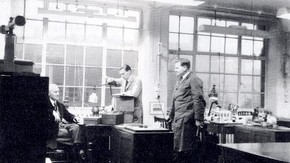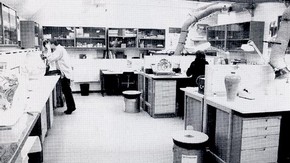Conservation Journal
April 1994 Issue 11
Recording the changes: V&A conservation departmental archive
The V&A Conservation Department has come a long way since 1960 when Norman Brommelle took a disparate group of craftsman, cum restorers, cum technicians and set up the first official conservation department in the Museum. He found morale 'rather low' and noted the 'deficiency in apparatus, especially of the more inexpensive and trivial items' 1 . A scientist himself, he introduced a strong scientific approach and set the Department on its way to being the professional group it has become.
His successor, Jonathan Ashley-Smith, broadened the scope of the conservator's role and took his staff beyond the confines of the Museum to international involvement and respect. Now, members of the Department attend and lecture at conferences in all parts of the world, bringing their expertise to a wider audience and, in turn, keeping abreast of current materials and techniques.
The early years of the Department are not so well documented and we must often rely on the memories of longer-serving and past members of staff for a picture of how things were. Although the topics are not always as scholarly as official Museum records, these pages provide a fascinating (and often hilarious) insight into the Department during the 1950s and 1960s. Characters with-a-capital-C abound and practises harmless but not always entirely official, were commonplace. But among the humour is a serious account of how hard-fought were the struggles to achieve the conditions and status enjoyed by present conservators. The purchase of the first X-ray machine in the Department is a typical example of the slow-moving process for acceptance of the need for more and better equipment than the craftsman's hand and eye 2 .
Such changes as the past three or four decades have seen need to be recorded, not only as an interesting piece of social history, but also as a reference for changes yet to come. It is not just the working patterns and responsibilities of the V&A conservator that have altered, but also the accommodation, equipment and techniques employed are very different from those known to previous generations. This is particularly pertinent now when the structure and accommodation of Conservation is again changing. Learning from past mistakes, or successes, may help in making the decisions for the next step in the Department's history. It is for these reasons that the archive is being set up, with the intention of providing access to as much information about the V&A Conservation Department as possible for researchers and other interested parties.
Originally, all the archive material was to have been housed together - perhaps in the Conservation Library - but, like Topsy, it has 'growed'. Currently, the plan is to house a core of material centrally but leave in situ other material which individual studios have collected. This of course would need the co-operation of staff: a blitz on files without conferring with the archivist could mean losing valuable information and, if the material is already catalogued, frustration for a researcher.
The whole will be catalogued, using a database (initially Cardbox), and eventually be available on the Conservation network. Using a retrieval system similar to that of a library, access would be by 'name', 'subject', 'material' etc, and a location given for the original material (text, photos etc.), with reference numbers given for Registered Papers kept in Registry or the Office of Arts & Libraries. As a reference resource, the 'core' material will need to be used on site and borrowing not available except briefly for copying: in the case of photographs a card or form system would need to be set up similar to the NAL's staff borrowing arrangement. Borrowing from studio files would be at the discretion of the Head of Section and the archivist advised of the loan for the database to be adjusted.
As a previous would-be archivist found, lack of time has pushed this project back as other work takes priority. However, having begun and become engrossed in the history of the Department, the prospect of recording its development is near to being realised and, hopefully, a useful source of research material accumulated.
References
1. 'Notes on the Conservation Department' by Norman Brommelle, c. February 1960
2. RPS VAl26 60/3488, V&A Registry archive
April 1994 Issue 11
- Editorial
- A saint unveiled
- 17th Century Chinese canopied bed
- Recording the changes: V&A conservation departmental archive
- The ageing & stabilisation of shellac varnish resin - an undergraduate research project at Imperial College
- Treatment of an early 18th Century Indian chintz qanat
- ICCROM - Japanese paper conservation course 1993: an introduction to the ancient skills of scroll mounting for the modern conservator
- Sand cast aluminium

